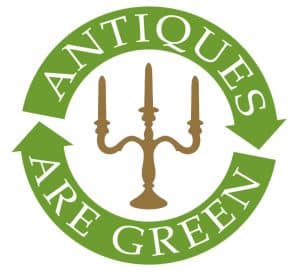Buy one antique or vintage item and together we can make a big difference
Below is our introduction, please scroll down to read about our Carbon footprint study on a Georgian chest of drawers and read the story of a chair’s lifetime journey, as featured by us on BBC Bargain hunt.
Introduction
We founded the Antiques are Green movement in September 2009, hundreds of antique and vintage businesses kindly agreed “to promote the green credentials of antiques.” We are very pleased to say it has now become commonplace for the green credentials of antiques to be cited by television presenters, journalists, dealers and consumers, frequently referencing the concept of reusing the past.
Having invested significant time and effort in the original movement, we are now re-launching Antiques are Green, as we feel the time is right to support the industry by increasing awareness. The aim is to help promote trade, products and services to consumers and increase the consideration of antiques as a purchase. Many of the economic changes, including the expansion of media channels, and the migration of antiques to on-line have helped to make antiques and vintage more accessible.
As a consequence we are introducing our new website, which we will continue to enhance as well as rejuvenate our social media efforts to raise press interest, trade opportunities and consumer interest. This time we are asking people to sign up to show their support so we can share and build a community which together can make a difference.
The importance of being green has significantly increased as a central component of corporate and social responsibility and now consumers are more focussed on sustainability. All businesses, whether large international corporations, or small family businesses, have become aware of the need to protect the environment. Companies nationally and internationally are actively endorsing a commitment to being green and consumer interest, awareness and spend is following.
We hope that you will support us by becoming part of our vision – a greener future created from the past.
The great work we did with the Antiques Trade Gazette on our original carbon footprint comparison of an antique versus modern chest of drawers remains regularly quoted and the article can be found here.
1.
Antiques are Green aims to encourage the purchase of antiques and vintage as a recognised sustainable green choice
2.
Antiques are Green aims to encourage existing consumers and new buyers, to buy just one item, as we believe small actions from many will make a considerable difference.
3.
Antiques are Green aims to encourage the trade and media to support antiques and vintage as an alternative green purchase.
4.
Antiques are Green will support consumers and the trade by connecting, sharing knowledge and promoting ideas.
5.
Antiques are Green wants to encourage consumers to see antiques and vintage as a way to personalise their home, garden or personal style by being unique and having fun.
6.
Antiques are Green like many, believes the time to act is now and no matter how small we intend to do our utmost to make some difference to the challenges we all face.
THE CARBON FOOTPRINT STUDY OF A GEORGIAN CHEST OF DRAWERS
Antique chest of drawers versus a modern one.
A new chest of drawers will have a carbon impact up to sixteen times higher than an antique chest of drawers.
Commissioned by members of the antiques trade, extensive independent research finally puts a figure on just how eco-friendly buying antiques can be.
The analysis compared the greenhouse gas emissions produced during the lifespan of two chest of drawers; one constructed in 1830 with an assumed lifespan of 195 years during which time it has been restored and sold twice and, the other, a new piece of similar value available from a reputable high street retailer with an assumed lifespan of 15 years. The detailed report focuses on all stages of each product’s lifecycle: from the sourcing of materials to the manufacturing processes, the transportation to the storage and finally to the disposal.
Antiques not only provide unique style and value for money but, as this report confirms with the pieces used for the research, the annual emissions of an antique piece can be as little as one sixteenth of those of its new equivalent.
In order to compare the footprint of the products based on their lifespan, the carbon footprint per year of use was calculated. This showed that the antique product has an annual carbon footprint of 0.72kg CO2e, whereas the new product has a footprint per year of use of 11.36kg CO2e. Therefore, a new chest of drawers will have a carbon impact sixteen times higher than an antique chest of drawers.
Nigel Worboys, founder of Antiques are Green Campaign and who spearheaded the research says “We launched the website www.antiquesaregreen.org last year to help communicate what ‘the trade’, had been thinking for quite a while. We’re delighted to have our thoughts confirmed – 16 times over! Buying antiques reduces landfill, reduces carbon emissions, reduces consumption of new goods from abroad and, preserves our heritage for future generations.”
Mark Hill, an expert on the Antiques Roadshow comments “There has never been a better time to buy antiques – not only do they provide us with excellent value for money and the opportunity to create our own individual style but they also enable us to help the environment through ‘glamorous recycling’ as confirmed by the facts in this insightful report.”
The study was conducted by Carbon Clear, an independent consultancy specialising in carbon management and carbon accounting. (acquired by EcoAct 2017).
How Antiques are Green
The Story of a Windsor Chair

Chair making in a Chilterns wood
The best way to illustrate this is by an example (this can be applied to many different antiques), in this case the humble Windsor chair:
The chair parts were made by craftsmen who lived in the woods where the materials came from. The turnings were produced by the same people working on foot powered treadle-operated lathes, then parts were taken on foot to a local workshop to be assembled. From there the completed chairs would be distributed around the country by horse and cart or waterways.
The chair saw a hard use but is still around today, these were made throughout the C19th. What a green product and what a life cycle!
By buying this chair to use again we have conserved our natural resources and prevented the carbon footprint of another chair being produced, that possibly would come all the way from the Far East. The buyer has a unique item, with character and of quality. We expect that a new mass produced chair will hit the waste tip long before this antique Windsor chair. Our Windsor chair will probably be sold again, maybe restored and revived then retailed and used again until who knows when.
Supported by

website

website

website

website

website
website

